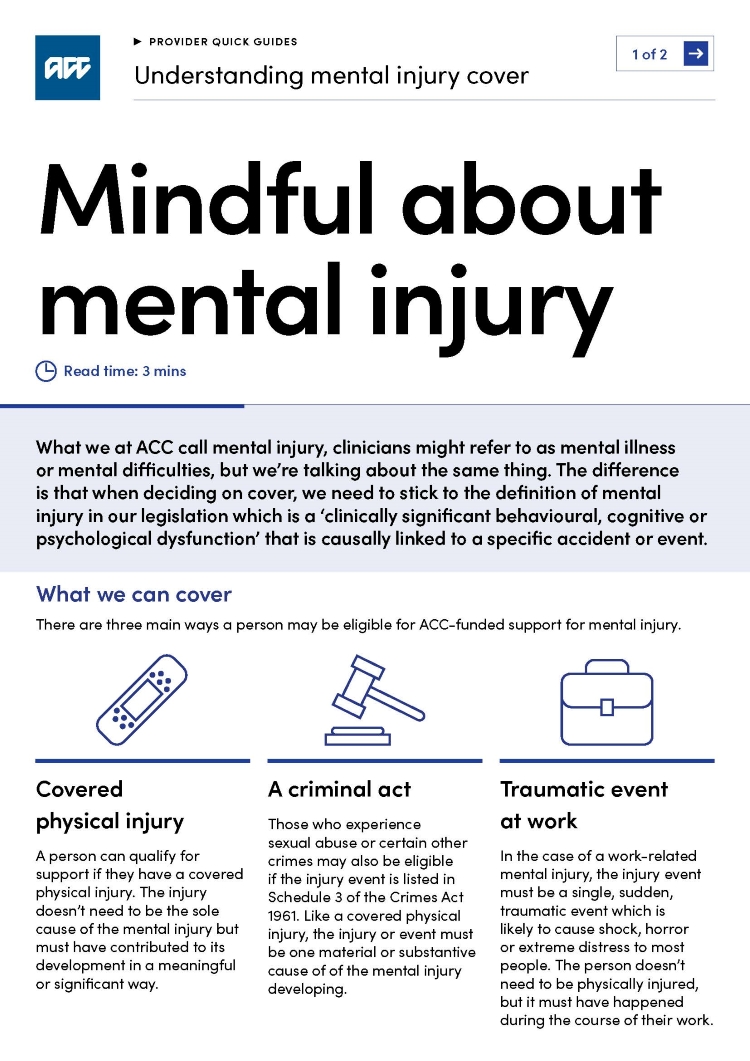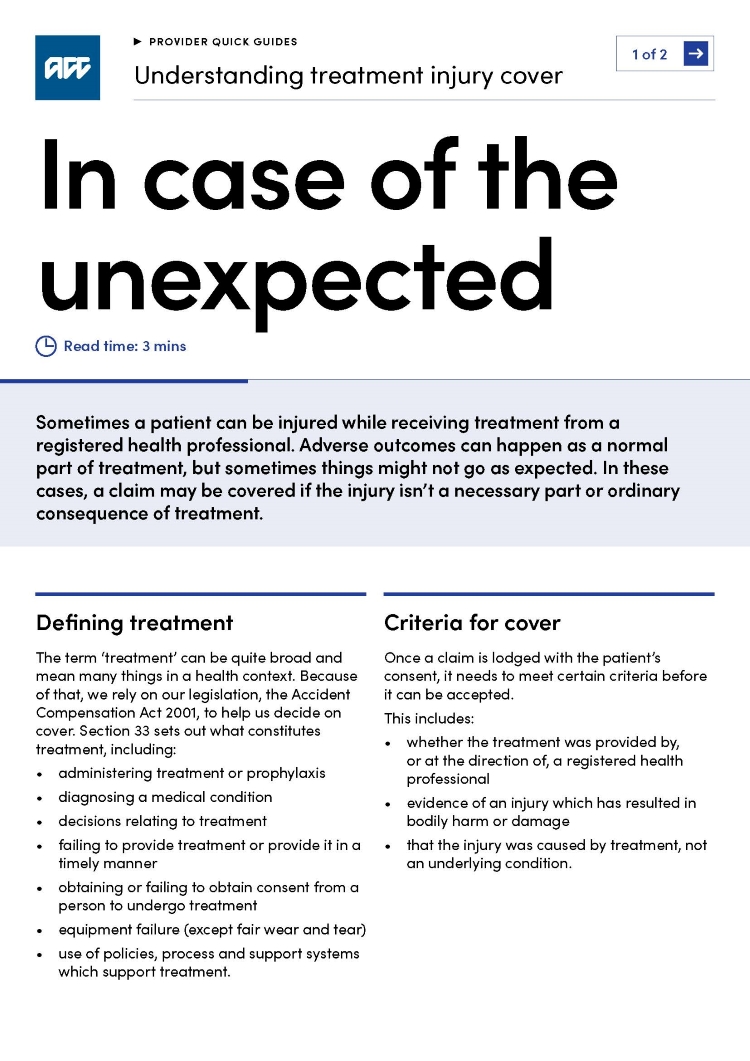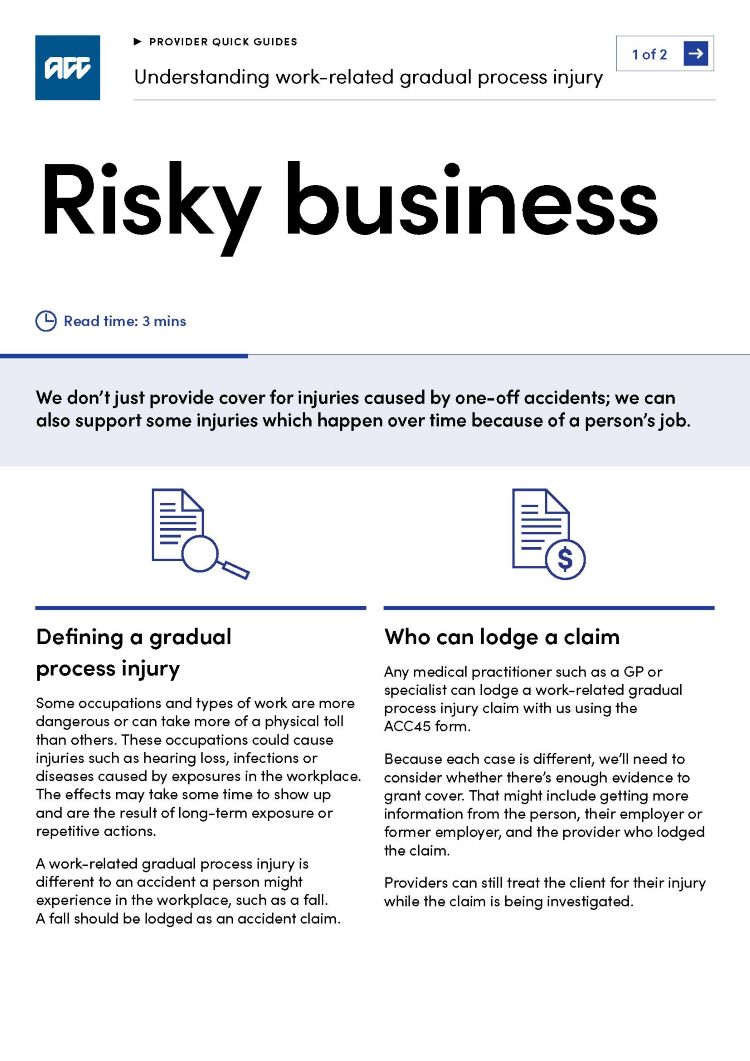Understanding complex cover
Complex cover typically relates to three main types of injury - mental injury, treatment injury and work-related gradual process injury. Each has their own criteria, process, and requirements.
If an injury isn't straightforward or if causation isn't immediately clear, we might need more time and information to make a cover decision. By understanding these types of cover you can help your patient access appropriate ACC-funded support for their recovery.
On this page
Mental injury cover
Video transcript for Mental injury cover
Visual
Screen shows An introduction to mental injury cover. Clock shows watch time of 4 minutes 14 seconds.
Text displays Penny Kokot Louw, Clinical Advice Manager.
Penny is sitting in a chair facing the camera. A pot plant, water jug, cup of water and pen and notepad sit on a small table beside her.
Transcript
Penny Kokot Louw: Understanding what we mean by mental injury can feel complex because, well, people are complex.
To help shed some light on this area of our cover, we’re going to explain our process for covering a mental injury and what support is available for our clients with a covered claim.
Visual
Screen shows What is a mental injury? Clock shows watch time of 22 seconds.
Screen cuts back to Penny in the chair.
Transcript
We know ‘mental injury’ may seem like an odd term. In a clinical setting, you’d probably use ‘mental illness’ or ‘mental distress’ instead.
These essentially mean the same thing except ‘mental injury’ is defined in our legislation as a ‘clinically significant behavioural, cognitive, or psychological dysfunction’.
Visual
Screen shows What's covered? Clock shows watch time of 36 seconds.
Screen cuts back to Penny in the chair.
Transcript
There are several situations where we may be able to provide cover.
These include if someone has developed mental distress which is caused by a covered physical injury, if they experience a traumatic event at work, or a criminal act like sexual abuse.
We can’t cover mental distress which is not directly caused by a physical injury or sexual abuse. But there is an exception if a person experiences a single, sudden traumatic event during their work.
Visual
Screen shows What's the process? Clock shows watch time of 1 minute 1 seconds.
Screen cuts back to Penny in the chair.
Transcript
If you’re a sexual abuse counsellor, a GP or other medical professional who’s treating one of our clients, you can lodge a mental injury claim with us.
When we receive it, we check whether it meets the criteria for cover. This will usually involve an assessment by a mental health professional or counsellor.
This is an important step because it helps us understand the causal link between the personal injury or event and the client’s mental condition.
Mental injury can be complicated because often there may be a number of factors which are contributing to a person’s mental distress.
To decide on cover, we need be sure the injury event has played a significant part in the mental condition developing.
We can’t provide cover if the assessment suggests the event has had a minor impact on the person’s distress or if it has made a pre-existing condition worse.
Visual
Screen shows What support is available? Clock shows watch time of 1 minute 9 seconds.
Screen cuts back to Penny in the chair.
Transcript
If the claim is accepted, it means we can tailor the appropriate care and support to meet the client’s unique needs.
We rely on the assessment report and treatment providers like you to recommend what support your client will need in their recovery.
Often this will include one-on-one talk therapy, but there is a range of other support available such as body-based therapy, group therapy, rongoā Māori, whānau support or social work support.
In some instances, a client may also be eligible for financial support.
While waiting for a cover decision, clients may be able to access supports such as counselling or psychological support.
While waiting for a cover decision, clients may be able to access supports such as counselling or psychological support.
Our Find Support website has a list of organisations with therapists available for clients with sensitive claims.
If clients do not qualify for psychological support or counselling through ACC, we can help by liaising with the client’s GP to arrange a referral to the right community mental health support.
And that’s the basics of mental injury cover. Thank you for watching.
Visual
Screen shows Mental injury cover.
Screen changes to roll through four statements: Needs to be caused by physical injury, traumatic events at work or criminal acts. Claims can be lodged by GPs, sexual abuse counsellors, and other medical professionals. Support is tailored to the client's recovery needs. Clients may access support while awaiting a cover decision.
Screen changes to show For more information and resources visit acc.co.nz/health-providers.
Screen changes again to show the ACC logo and tagline He Kaupare. He Manaaki. He Whakaora. Prevention. Care. Recovery.
Clinicians may commonly refer to this as mental illness or distress, but we use the term 'mental injury' which is defined in the Accident Compensation Act 2001.
We can offer ACC-funded support, such as counselling, to those who experience a mental injury as a result of three main circumstances:
- covered physical injury
- criminal act
- traumatic event at work.
Sexual abuse counsellors, GPs or other medical professionals treating an ACC client can lodge a mental injury claim. Each claim is considered based on the person's unique experience and their recovery needs are informed by practitioner reports and recommendations.
Mental injury at a glance
| Injury | Caused by | Claim example | What we can't cover |
| Mental injury - defined in AC Act 2001 as a "clinically significant behavioural, cognitive or psychological dysfunction" |
|
|
|
Webinar
Our two-part beginner's guide to ACC for mental injury providers webinar equips new and existing providers with the information they need to understand the area of mental injury and how to work together successfully.
Part 1 is an introduction to ACC, cover and causation, while part 2 provides practical advice and tips on completing a strong report and assessment, expectations of providers and types of support available for clients with an accepted claim.
Both are available on-demand now.

Quick guide: Mental injury cover
Get an at-a-glance view of mental injury – what's covered, what's not and what support is available for clients with an accepted claim.
Treatment injury cover
Video transcript for Treatment injury cover
Visual
Screen shows Understanding treatment injury cover. Clock shows watch time of 3 minutes 16 seconds.
Text displays Dr Rochelle Phipps, Medical Advisor.
Penny is sitting in a chair facing the camera. A pot plant, water jug, cup of water and pen and notepad sit on a small table beside her.
Transcript
Dr Rochelle Phipps: Sometimes a patient can be injured while they’re receiving care from a registered health professional.
Adverse outcomes can happen as a normal part of providing treatment, but sometimes things might not go as expected.
In these cases, we may be able to provide cover to patients for a personal injury caused by treatment.
Here’s what you need to know about Treatment Injury cover.
Visual
Screen shows When should I lodge a treatment injury claim? Clock shows watch time of 13 seconds.
Screen cuts back to Rochelle in the chair.
Transcript
You should consider lodging a treatment injury claim with us if the patient’s injury isn’t a necessary part or ordinary consequence of the treatment.
Once we receive a claim, there are some things we consider before making a decision about cover.
Visual
Screen shows What's the criteria for treatment injury cover? Clock shows watch time of 51 seconds.
Screen cuts back to Rochelle in the chair.
Transcript
The first thing we need to know is whether treatment has been provided by, or at the direction of, a registered health professional.
Our legislation gives us a very broad definition of what constitutes treatment, and this includes where there has been a failure to provide treatment.
We also need to see that there’s evidence of an injury which has resulted in bodily harm or damage to the patient.
This could be something like a severed nerve which is causing pain or numbness.
Under our legislation, symptoms without an identifiable physical injury are not coverable.
The patient’s injury must also have been caused by a treatment, not an underlying condition.
Sometimes that may not be immediately clear, but we'll consider the evidence and decide causation on the balance of probability. In other words, whether it is more likely than not that treatment has caused the injury.
Visual
Screen shows Are there any exclusions to cover? Clock shows watch time of 1 minute 7 seconds.
Screen cuts back to Rochelle in the chair.
Transcript
There are some situations which aren’t coverable under our legislation.
The main reason is if the injury is a necessary part or ordinary consequence of treatment.
For example, if a surgeon needs to make an incision of the abdomen, we know this will cause direct damage to the skin and underlying structures. This is a necessary part of treatment.
Sometimes an incisional hernia develops at the treatment site. At stoma sites for example, this is very common and not unexpected. This would be considered an ordinary consequence of the treatment.
The Courts have provided guidance on how to consider whether an injury is an ordinary consequence. This must take into account the clinical knowledge at the time of treatment, and the underlying health condition of the patient.
Because everyone and every situation is unique, we consider treatment injury claims on a case-by-case basis.
That means while a claim may be accepted for one patient, it may not be for another.
And that’s the basics of treatment injury.
If you want to know more, take a look at the Treatment Injury Claim Lodgement Guide on our website.
Thanks for watching.
Visual
Screen shows Treatment injury cover.
Screen changes to roll through four statements: Covers injuries which aren’t a necessary part or ordinary consequence of treatment. Is guided by the AC Act 2001 and the courts. Claims are considered on a case-by-case basis. Complex cases are decided on evidence and balance of probability.
Screen changes to show For more information and resources visit acc.co.nz/health-providers.
Screen changes again to show the ACC logo and tagline He Kaupare. He Manaaki. He Whakaora. Prevention. Care. Recovery.
Injuries can occur while a person is receiving care or treatment from a registered health professional. Sometimes this is a necessary part or ordinary consequence of the treatment, but the unexpected can also happen.
In those cases, we may be able to provide treatment injury cover and ACC-funded support for recovery.
Lodging a treatment injury
Any registered treatment provider can lodge a treatment injury claim, it doesn't need to be the provider who delivered services when the injury occurred.
To lodge a treatment injury claim, submit an ACC2152 Claim for treatment injury form alongside the usual ACC45 claim lodgement form. To help our cover assessors make quicker decisions, it's helpful to include supporting clinical documentation as supporting evidence. This might include, but is not limited to:
- lab reports
- referral letter
- x-ray reports
- MRI reports
- operative notes
- discharge summaries.
Once a claim is lodged, there are a few criteria we need to consider.
Because no situation is the same, treatment injury cover decisions are made on a case-by-case and may need a external specialist assessment if the claim is complex.
Examples of these are:
- failure in the provision of treatment
- neonatal birth injuries
- neurological conditions
- male and female fertility
- hepatitis C
- mental injury
- death.
Treatment injury at a glance
| Injury | Caused by | Claim example | What we can't cover |
| Treatment injury |
Treatment given by, or at the direction of, a registered healthcare professional This includes omission of treatment and failure of medical equipment |
|
|

Quick guide: Treatment injury cover
Learn how we decide cover for treatment injury and what information is helpful to include when making a claim.
Work-related gradual process injury cover
Video transcript for Work-related gradual process injury cover
Visual
Screen shows Understanding work-related gradual process injury cover. Clock shows watch time of 3 minutes 36 seconds.
Text displays Dr Milly Hanlon Occupational Physician.
Milly is sitting in a chair facing the camera. A pot plant, water jug, cup of water and pen and notepad sit on a small table beside her.
Transcript
Dr Milly Hanlon: Here at ACC, we don’t just provide cover for injuries caused by one-off accidents.
We can also fund support for some injuries and conditions which happen over time and because of a person’s job.
This is what you need to know about cover for a work-related gradual process injury.
Visual
Screen shows What's a work-related gradual process injury? Clock shows watch time of 37 seconds.
Screen cuts back to Milly in the chair.
Transcript
We know certain types of work are more dangerous or can take more of a physical toll than others.
For example, firefighting, factory work, construction, building and other trades.
These types of injuries can include hearing loss or infections and diseases caused by exposure to substances such as silica or asbestos.
The effects of these might not show up straight away and will be the result of long-term exposure or repetitive actions over time.
A work-related gradual process injury is different from an accident a person may experience in the workplace, such as a fall.
Visual
Screen shows How does ACC decide on cover? Clock shows watch time of 50 seconds.
Screen cuts back to Milly in the chair.
Transcript
The legislation that governs what we can cover sets out the criteria of what we can accept as a work-related gradual process injury.
The first thing is whether the tasks the person did, or their work environment, caused or contributed to the cause of their injury.
Secondly, whether it’s more likely the injury was caused by work-related circumstances than in the person’s everyday life.
And thirdly, if the person was at more risk of this kind of injury because of their job or work environment compared to others who don’t do that type of work.
There are some cases where we won’t be able provide cover.
For example, if the person has a pre-existing condition which is made worse because of their work.
In some cases, we might need special assessments to make a cover decision.
Visual
Screen shows What's an example of a work-related gradual process injury? Clock shows watch time of 1 minute 8 seconds.
Screen cuts back to Milly in the chair.
Transcript
Let’s use Simon as an example. Simon works as a floor layer and has been diagnosed with prepatellar bursitis – that’s swelling of the soft tissue around the kneecap.
We know his job includes repeated or extended kneeling for hours each day, which can cause prepatellar bursitis.
To meet the criteria for cover, we’d need to know if the activities he does outside of work, like gardening, or any pre-existing conditions, such as diabetes, haven’t played a significant part in his injury.
Next, we know floor layers have a greater risk of developing prepatellar bursitis compared to those who aren’t in this line of work.
In this case, Simon’s injury would meet the criteria for cover.
Once a claim is accepted, the client would have access to appropriate ACC-funded services to help in their recovery and journey back to independence.
This could include things like surgery, rehabilitation, home help or weekly compensation.
And there you have it. The basics of work-related gradual process injury cover.
Thanks for watching.
Visual
Screen shows Work-related gradual process injury cover.
Screen changes to roll through three statements: Happens over time and based on a person's job. Includes hearing loss or infections and disease and may take years to show up. Cover is guided by the AC Act 2001 and doesn't include pre-existing conditions.
Screen changes to show For more information and resources visit acc.co.nz/health-providers.
Screen changes again to show the ACC logo and tagline He Kaupare. He Manaaki. He Whakaora. Prevention. Care. Recovery.
This type of cover is for people who are at greater risk of injury, infection, or disease because of their job compared to others who don't work in those sectors. They might be a firefighter, builder, tradesperson, or someone who works in loud environments.
These injuries can develop gradually, and the impact might not be apparent for some time, even after the person is no longer exposed to those working conditions.
They're injuries which can occur because of long-term exposure to substances like asbestos or silica or repetitive actions like kneeling. An example which might be considered for cover is cancer caused by exposure to asbestos in a person's work environment over a number of years.
These are different to an accident a person might experience in the workplace such as a fall.
Lodging a work-related gradual process injury
A claim can be lodged by ticking the work-related gradual process injury box in Section D of the ACC45 form. Including relevant clinical information to support the claim will help us make a cover decision faster.
We consider each claim based on the evidence we receive, but we may also need to gather more information, including from the person, their employer or former employer, and the provider who lodged the claim.
While we're doing that, the client can still receive treatment for the injury.
Work-related gradual process injury at a glance
| Injury | Caused by | Claim example | What we can't cover |
| Work-related gradual process injury | Work tasks or environment which happens over time |
|
|

Quick guide: Work-related gradual process injury cover
Find out what's covered, what's not and how to lodge a claim for a work-related gradual process injury.